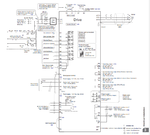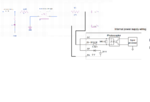seyyah
Advanced Member level 2
I have a device to control shown in the attachment. I need to send commands to the inputs of the device. Inputs of the device are shown in the attachment. They are triggered by applying gnd to the inputs of the device. I have access only to the 2 terminals of the input; command and gnd(common). Normally I do it by using relay. But I want to replace it with a semiconductor device. As shown in figure; scenario A is not working but B is working. In order to apply scenario B I need 3rd terminal of the device: VDD. And that is not an option. What can I do? Thanks.




